Performance Analysis of Externally Pressurized Gas Journal Bearing Lubricated with Vapor of R134a in Centrifugal Compressor
Abstract
:1. Introduction
2. Mathematical Model
2.1. Governing Equation
2.2. Numerical Analysis
2.3. Boundary Conditions
3. Results and Discussion
3.1. Influence of Average Clearance
3.2. Influence of Supply Pressure
3.3. Influence of Eccentricity Ratio
4. Conclusions
- (1)
- There is an ideal average clearance with the highest load capacity and gas bearing stiffness. The corresponding value of average clearance for R134a gas journal bearings is smaller than that in air gas bearings. For R134a journal bearings, the average clearance and diameter of orifice should be designed smaller than air bearings to obtain a larger load capacity and stiffness.
- (2)
- For R134a gas journal bearings, there is an ideal supplied pressure that allows for the maximum load capacity. The optimal value of the supply pressure is determined by the diameter of orifice and average clearance under the fixed eccentricity ratio. Compared with air gas bearings, the optimal supply pressure is lower than that of air bearings.
- (3)
- The mass flow rate of R134a gas journal bearings is larger than that of air bearings. The diameter of orifice has a larger impact on the mass flow rate consumed by gas bearings than supply pressure and eccentricity ratio.
Author Contributions
Funding
Data Availability Statement
Conflicts of Interest
Abbreviations
| A | the cross-sectional area of the orifice |
| coefficient matrices | |
| d | orifice diameter |
| e | eccentricity |
| h | clearance |
| dimensionless clearance | |
| k | the ratio of specific heat |
| K | stiffness |
| L | bearing length |
| the mass flow rate | |
| p | film pressure |
| dimensionless pressure | |
| pa | working atmospheric pressure |
| ps | supply pressure |
| R | bearing radius |
| the dimensionless mass flow factor of the orifice | |
| u | velocity of the working fluid in the circumferential direction |
| w | velocity of the working fluid in the axial direction |
| W | load capacity |
| the velocity of working fluid through the orifice | |
| The pressure ratio | |
| x, y, z | coordinates |
| dimensionless coordinates | |
| ω | angular velocity |
| ε | the eccentricity ratio |
| δ | Kronecker symbol |
| μ | the dynamic viscosity |
| θ | the angular coordinate |
| Λ | the bearing number |
| ρ | density |
| φ | the discharge coefficient |
References
- Liu, H.; Zhang, Z.; Li, H.; Wang, S.; Hu, B.; Wang, R. Research and development of a permanent-magnet synchronous frequency-convertible centrifugal compressor. Int. J. Refrig. 2020, 117, 33–43. [Google Scholar] [CrossRef]
- Lissandrin, M.; Rampazzo, M.; Cecchinato, L.; Beghi, A. Optimal operational efficiency of chillers using oil-free centrifugal compressors. Int. J. Refrig. 2017, 82, 83–96. [Google Scholar] [CrossRef]
- Kus, B.; Nekså, P. Oil free turbo-compressors for CO2 refrigeration applications. Int. J. Refrig. 2013, 36, 1576–1583. [Google Scholar] [CrossRef]
- Gao, S.; Cheng, K.; Chen, S.; Ding, H.; Fu, H. Computational design and analysis of aerostatic journal bearings with application to ultra-high speed spindles. Proc. Inst. Mech. Eng. Part C J. Mech. Eng. Sci. 2016, 231, 1205–1220. [Google Scholar] [CrossRef]
- Gao, S.; Cheng, K.; Chen, S.; Ding, H.; Fu, H. CFD based investigation on influence of orifice chamber shapes for the design of aerostatic thrust bearings at ultra-high speed spindles. Tribol. Int. 2015, 92, 211–221. [Google Scholar] [CrossRef]
- Song, L.; Cheng, K.; Ding, H.; Chen, S.; Gao, Q. The static performance of the high-speed aerostatic spindles with modified discharge coefficients. Proc. Inst. Mech. Eng. Part B J. Eng. Manuf. 2020, 28, 1–13. [Google Scholar] [CrossRef]
- Ise, T.; Arita, N.; Asami, T.; Kawashima, I.; Maeda, T.; Nakajima, T. Experimental study of small-size air turbo blower supported by externally pressurized conical gas bearings. Mech. Mach. Theory 2015, 84, 57–66. [Google Scholar] [CrossRef]
- Tkacz, E.; Kozanecka, D.; Kozanecki, Z.; Miazga, K. Investigations of Oil–Free Support Systems to Improve the Reliability of ORC Hermetic High–Speed Turbomachinery. Mech. Mech. Eng. 2011, 15, 355–365. [Google Scholar]
- Kaczmarczyk, T.Z.; Zywica, G.; Ihnatowicz, E. The impact of changes in the geometry of a radial microturbine stage on the efficiency of the micro CHP plant based on ORC. Energy 2017, 137, 530–543. [Google Scholar] [CrossRef]
- Šimek, J.; Lindovský, P. Development of aerodynamic bearing support for application in air cycle machines. Appl. Comput. Mech. 2014, 8, 101–114. [Google Scholar]
- Kus, B.; Nekså, P. Development of one-dimensional model for initial design and evaluation of oil-free Co2 turbo-compressor. Int. J. Refrig. 2013, 36, 2079–2090. [Google Scholar] [CrossRef]
- Dykas, B.; Bruckner, R.; DellaCorte, C.; Edmonds, B.; Prahl, J. Design, Fabrication, and Performance of Foil Gas Thrust Bearings for Microturbomachinery Applications. J. Eng. Gas Turbines Power 2008, 131, 012301. [Google Scholar] [CrossRef]
- Wright, S.A.; Radel, R.F.; Vernon, M.E.; Pickard, P.S.; Rochau, G.E. Operation and analysis of a supercritical CO2 Brayton cycle. In Sandia Report, No. SAND2010-0171; Sandia National Laboratories: Albuquerque, NM, USA, 2010. [Google Scholar] [CrossRef] [Green Version]
- Schiffmann, J.; Favrat, D. Experimental investigation of a direct driven radial compressor for domestic heat pumps. Int. J. Refrig. 2009, 32, 1918–1928. [Google Scholar] [CrossRef]
- Schiffmann, J.; Favrat, D. Design, experimental investigation and multi-objective optimization of a small-scale radial compressor for heat pump applications. Energy 2010, 35, 436–450. [Google Scholar] [CrossRef]
- Schiffmann, J.; Kontomaris, K.; Arpagaus, C.; Bless, F.; Bertsch, S. Scale limitations of gas bearing supported turbocompressors for vapor compression cycles. Int. J. Refrig. 2019, 109, 92–104. [Google Scholar] [CrossRef]
- Demierre, J.; Favrat, D.; Schiffmann, J.; Wegele, J. Experimental investigation of a Thermally Driven Heat Pump based on a double Organic Rankine Cycle and an oil-free Compressor-Turbine Unit. Int. J. Refrig. 2014, 44, 91–100. [Google Scholar] [CrossRef]
- Wu, T.; Meng, X.; Wei, X.; Han, J.; Ma, X.; Han, J.; Shao, L. Design and performance analysis of a radial inflow turbogenerator with the aerostatic bearings for organic Rankine cycle system. Energy Convers. Manag. 2020, 214, 112910. [Google Scholar] [CrossRef]
- Cui, H.; Gong, W.; Zheng, Y.; Li, Y.; Wang, W.; Jiang, Z. A simplified FEM analysis on the static performance of aerostatic journal bearings with orifice restrictor. Proc. Inst. Mech. Eng. Part J J. Eng. Tribol. 2020, 235, 1379–1389. [Google Scholar] [CrossRef]
- Lo, C.-Y.; Wang, C.-C.; Lee, Y.-H. Performance analysis of high-speed spindle aerostatic bearings. Tribol. Int. 2005, 38, 5–14. [Google Scholar] [CrossRef]
- Garcia, M.; Bou-Saïd, B.; Rocchi, J.; Grau, G. Refrigerant foil bearing behavior—A Thermo-HydroDynamic study: (Application to rigid bearings). Tribol. Int. 2013, 65, 363–369. [Google Scholar] [CrossRef]
- Bouchehit, B.; Bou-Saïd, B.; Garcia, M. Static and dynamic performances of refrigerant-lubricated bearings. Tribol. Int. 2016, 96, 326–348. [Google Scholar] [CrossRef]
- Schiffmann, J.; Favrat, D. The effect of real gas on the properties of Herringbone Grooved Journal Bearings. Tribol. Int. 2010, 43, 1602–1614. [Google Scholar] [CrossRef]
- Liu, Z.-S.; Zhang, G.-H.; Xu, H.-J. Performance analysis of rotating externally pressurized air bearings. Proc. Inst. Mech. Eng. Part J J. Eng. Tribol. 2008, 223, 653–663. [Google Scholar] [CrossRef]
- Yan, H.; Ke, C.; Peng, N.; Li, K.; Zhang, X.; Xiong, L.; Dong, B.; Li, J.; Liu, L. Performance prediction of externally pressurized gas bearings for high-speed turbo-expander involving hydrogen, helium and air working fluids. Int. J. Hydrogen Energy 2021, 46, 33453–33467. [Google Scholar] [CrossRef]
- Zhang, J.; Yu, F.; Zou, D.; Ta, N.; Rao, Z. Comparison of the characteristics of aerostatic journal bearings considering misalignment under pure-static and hybrid condition. Proc. Inst. Mech. Eng. Part J: J. Eng. Tribol. 2018, 233, 769–781. [Google Scholar] [CrossRef]
- Li, Y.; Zhou, K.; Zhang, Z. A flow-difference feedback iteration method and its application to high-speed aerostatic journal bearings. Tribol. Int. 2015, 84, 132–141. [Google Scholar] [CrossRef]
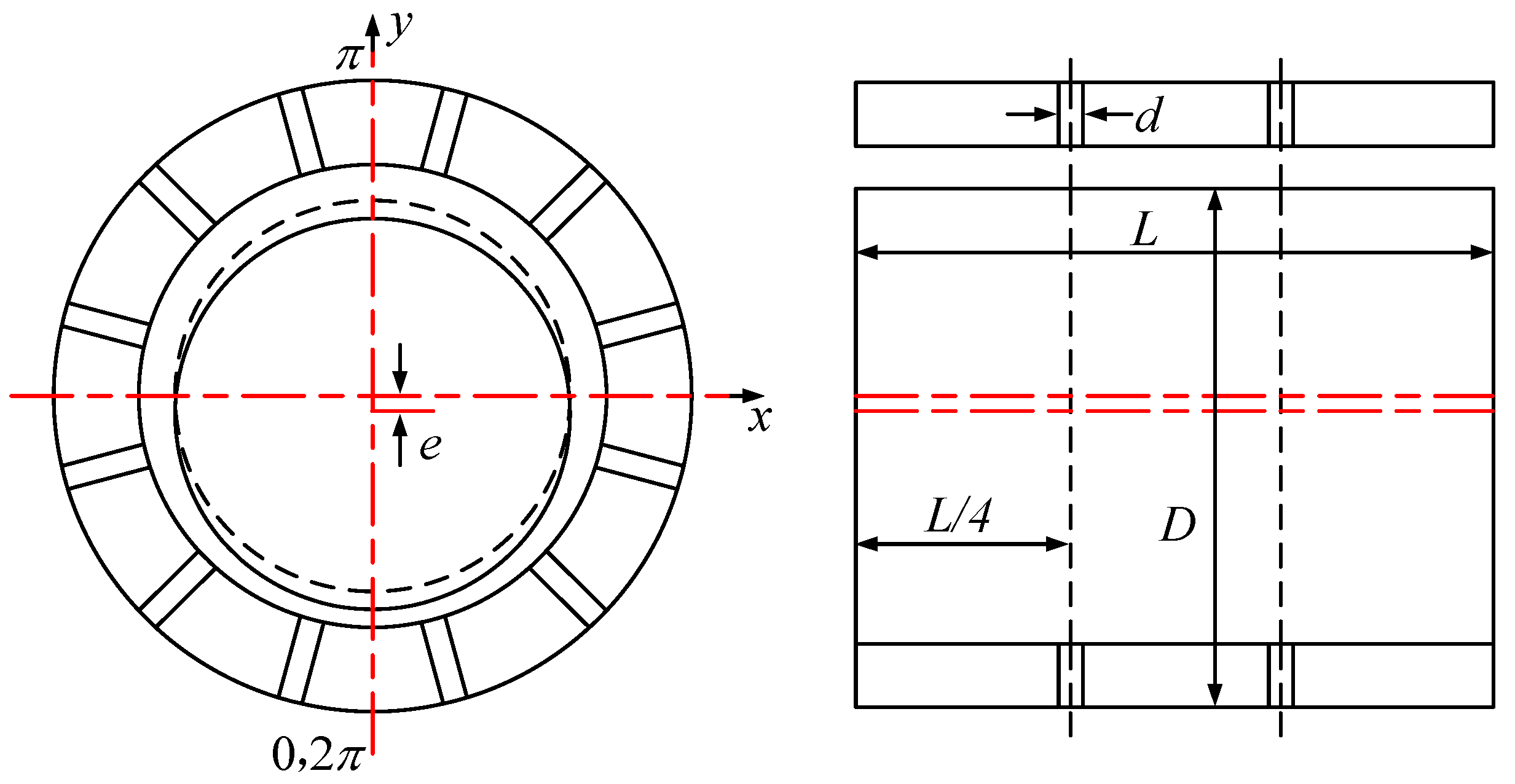
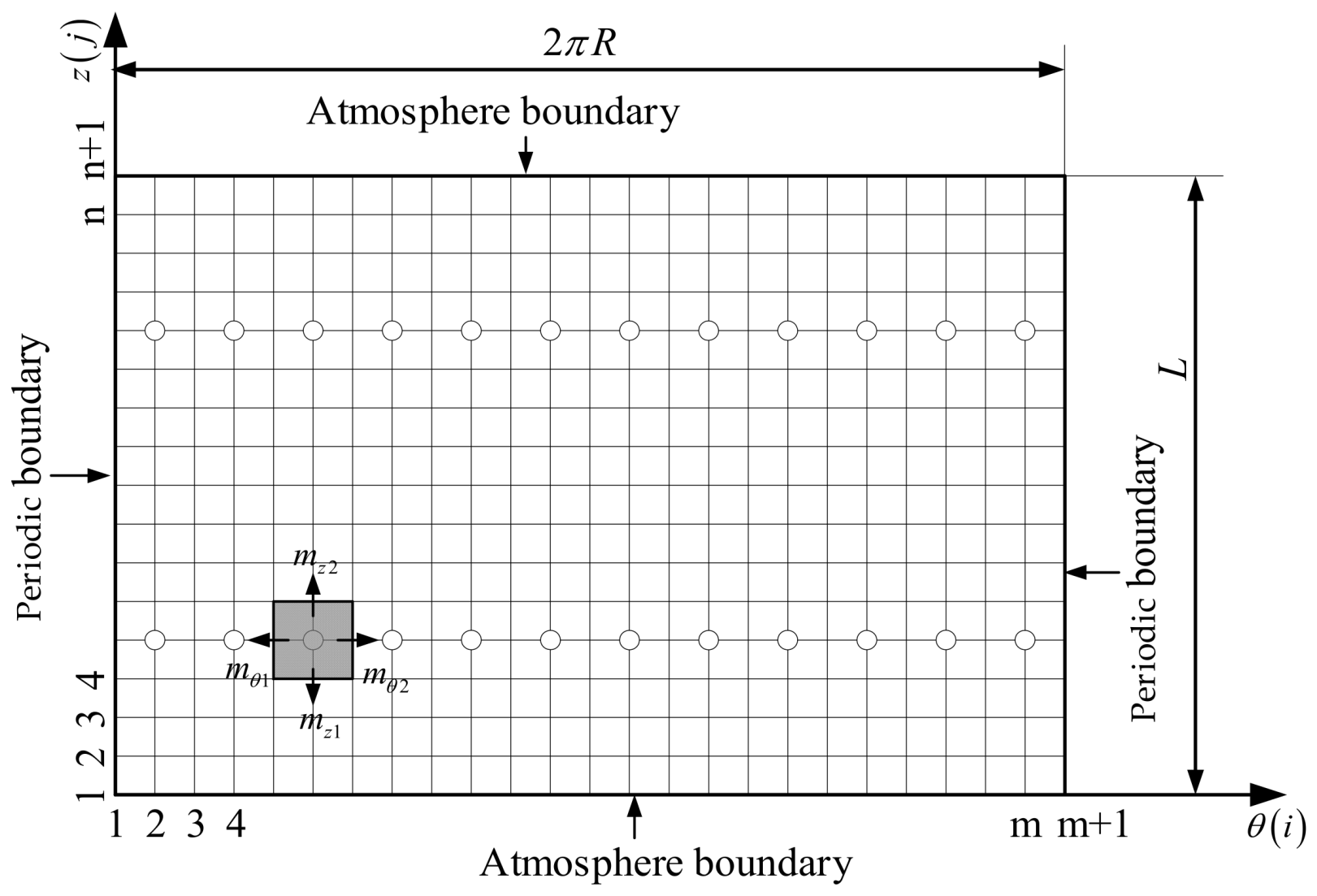



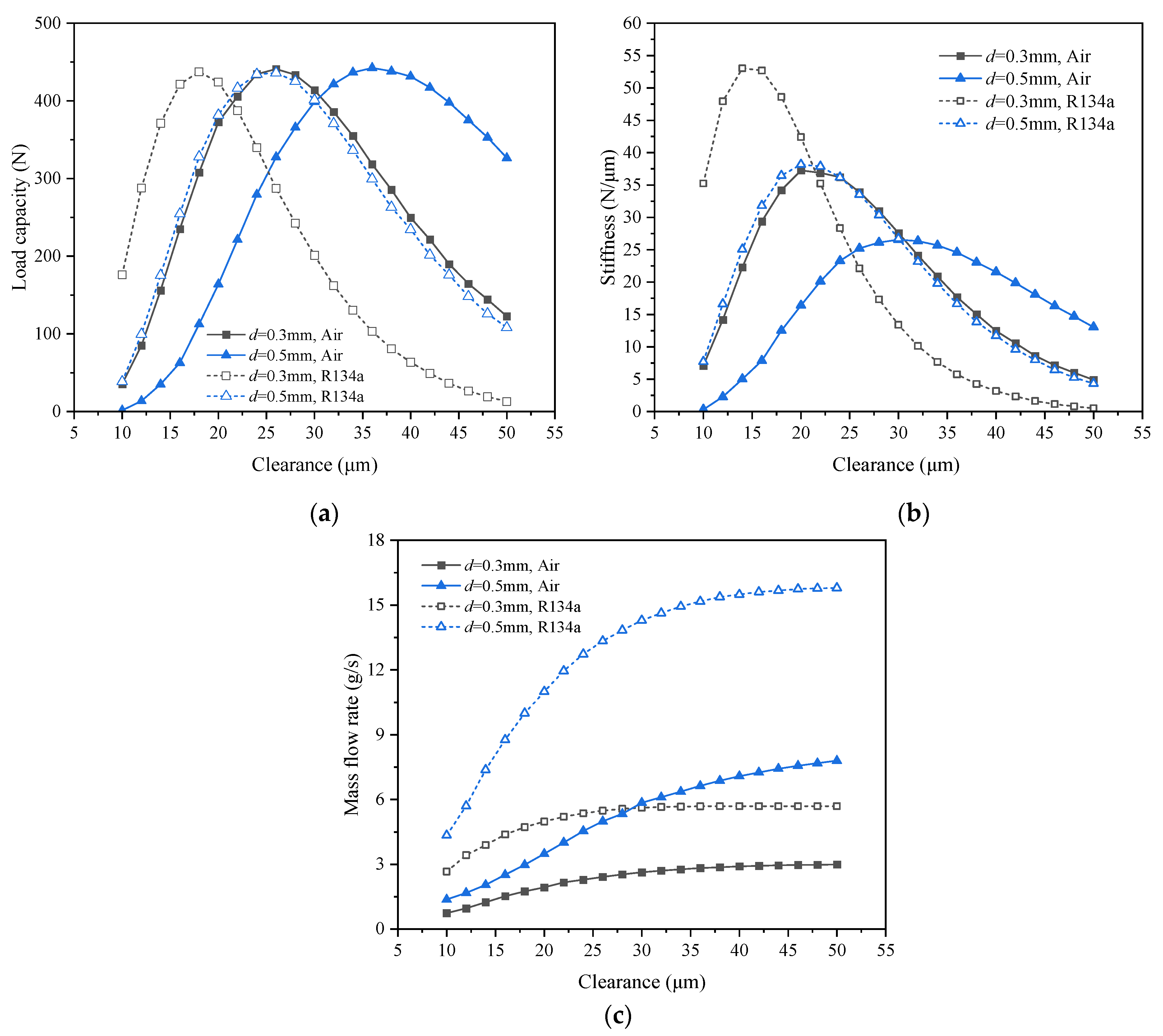
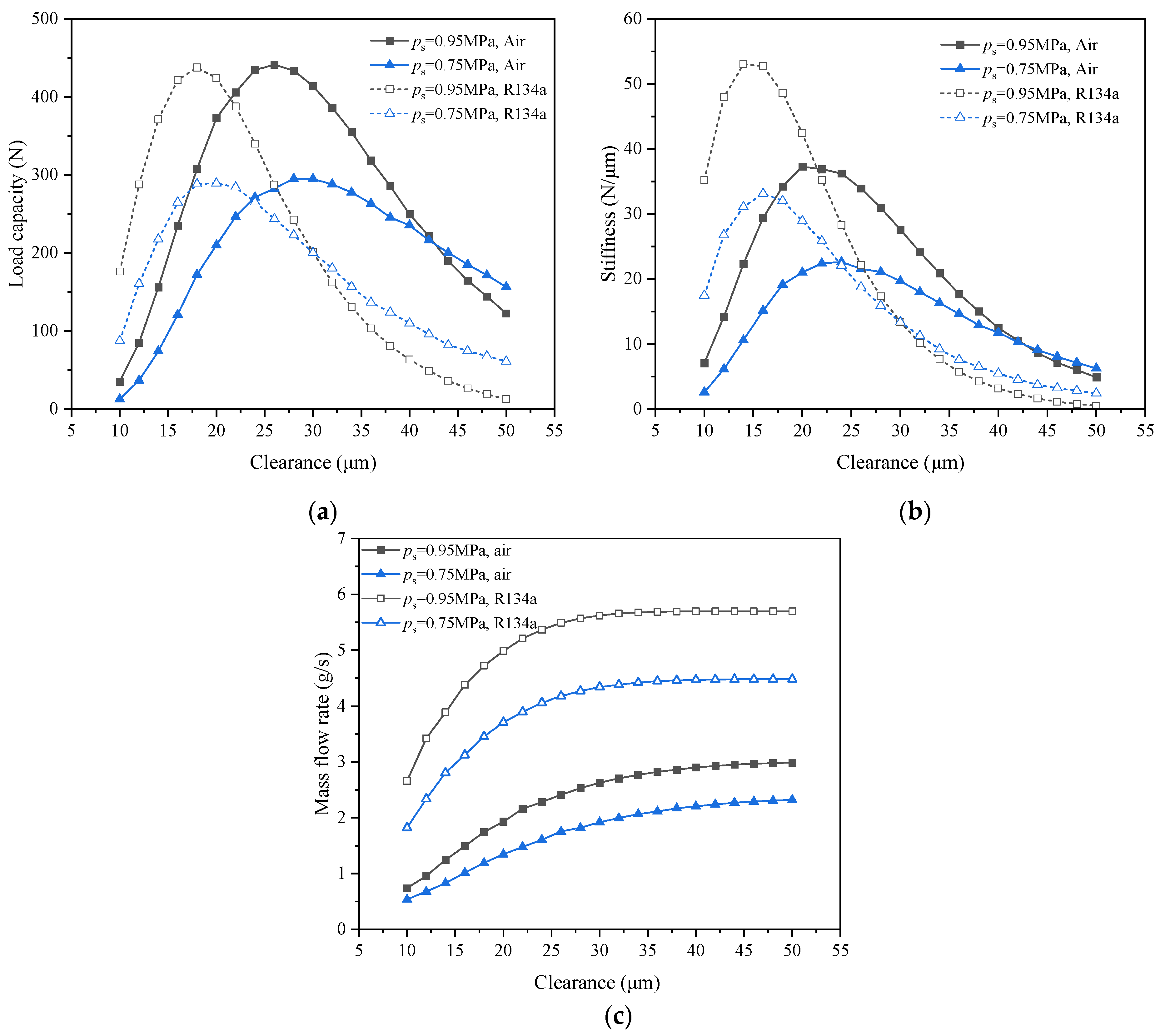
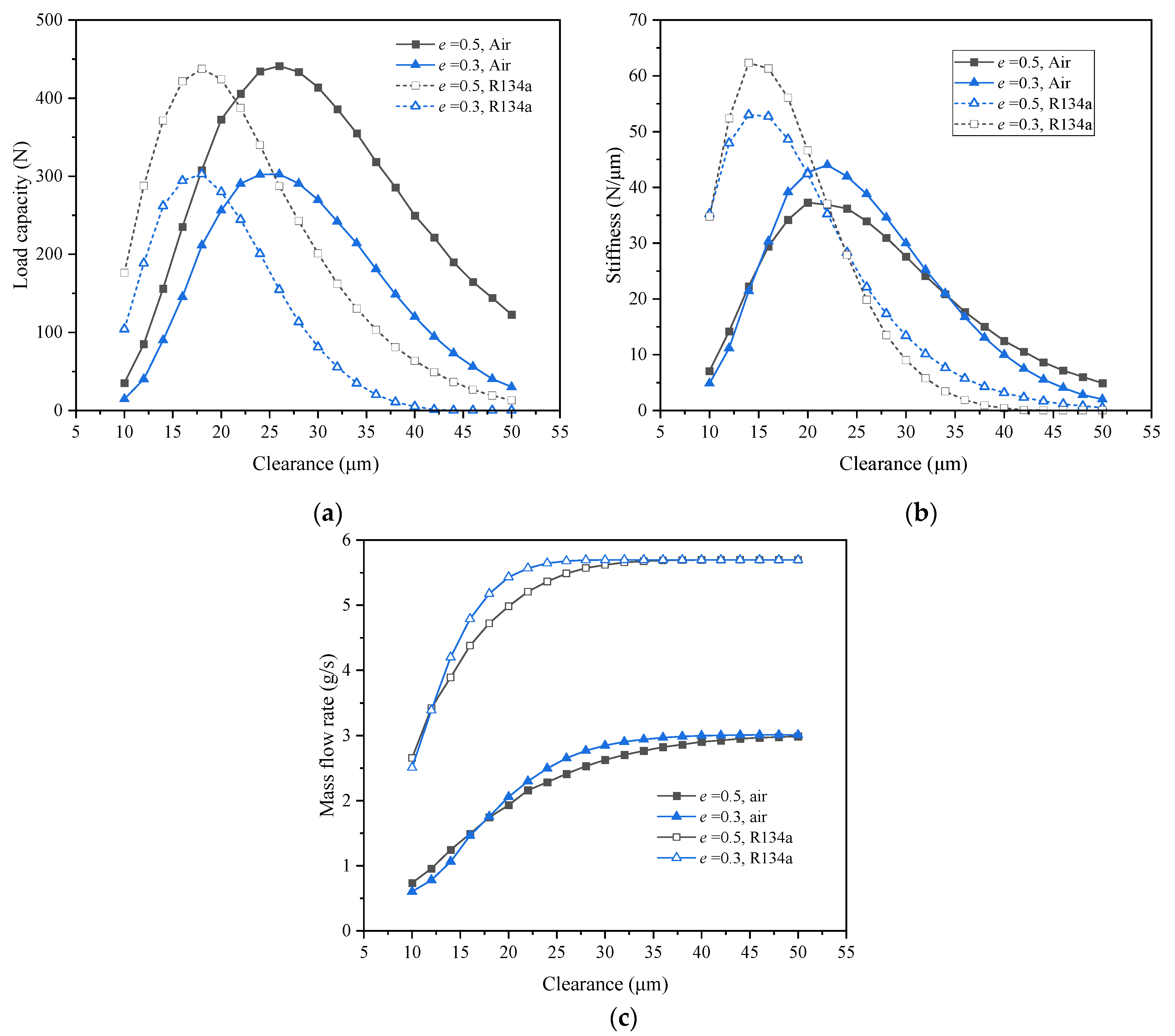
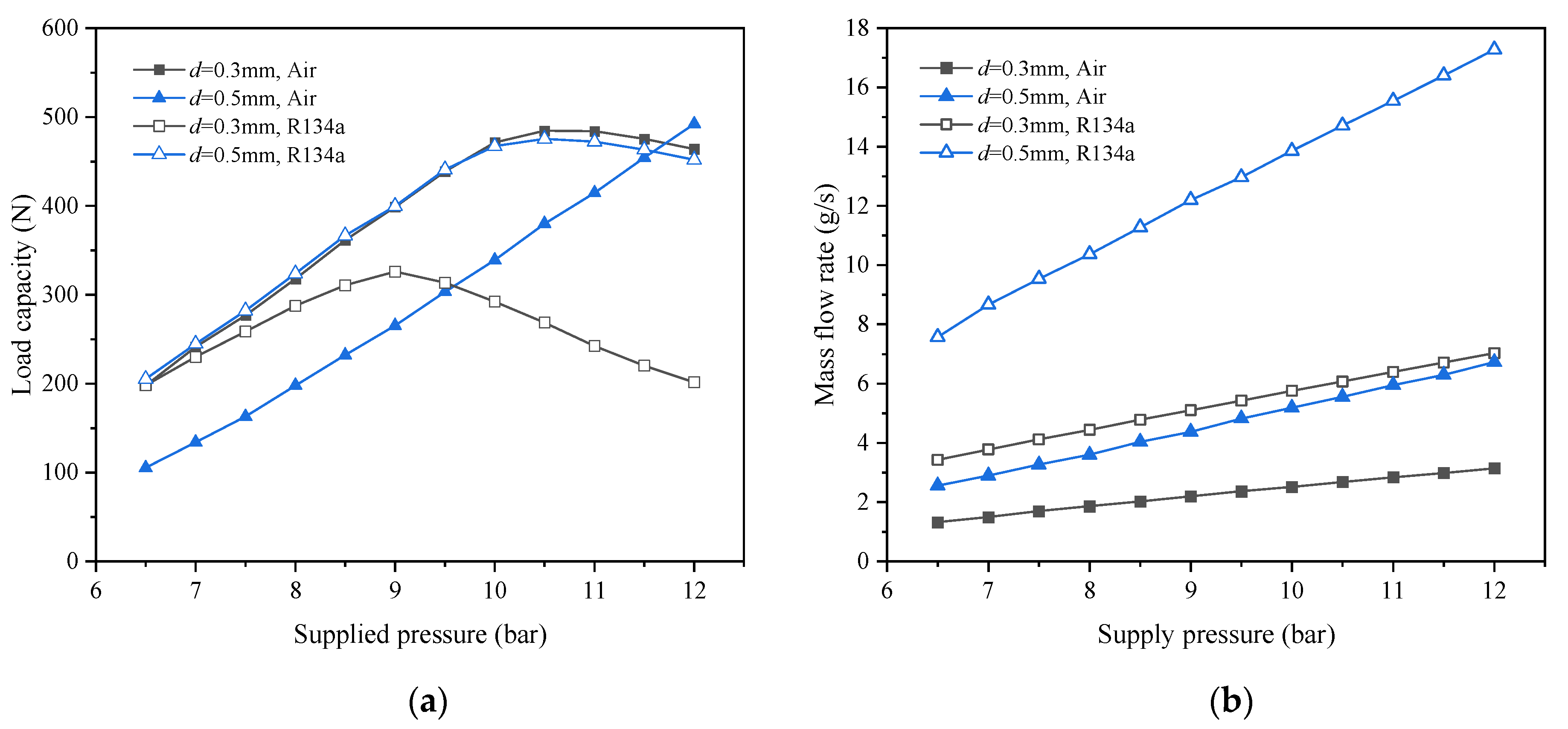
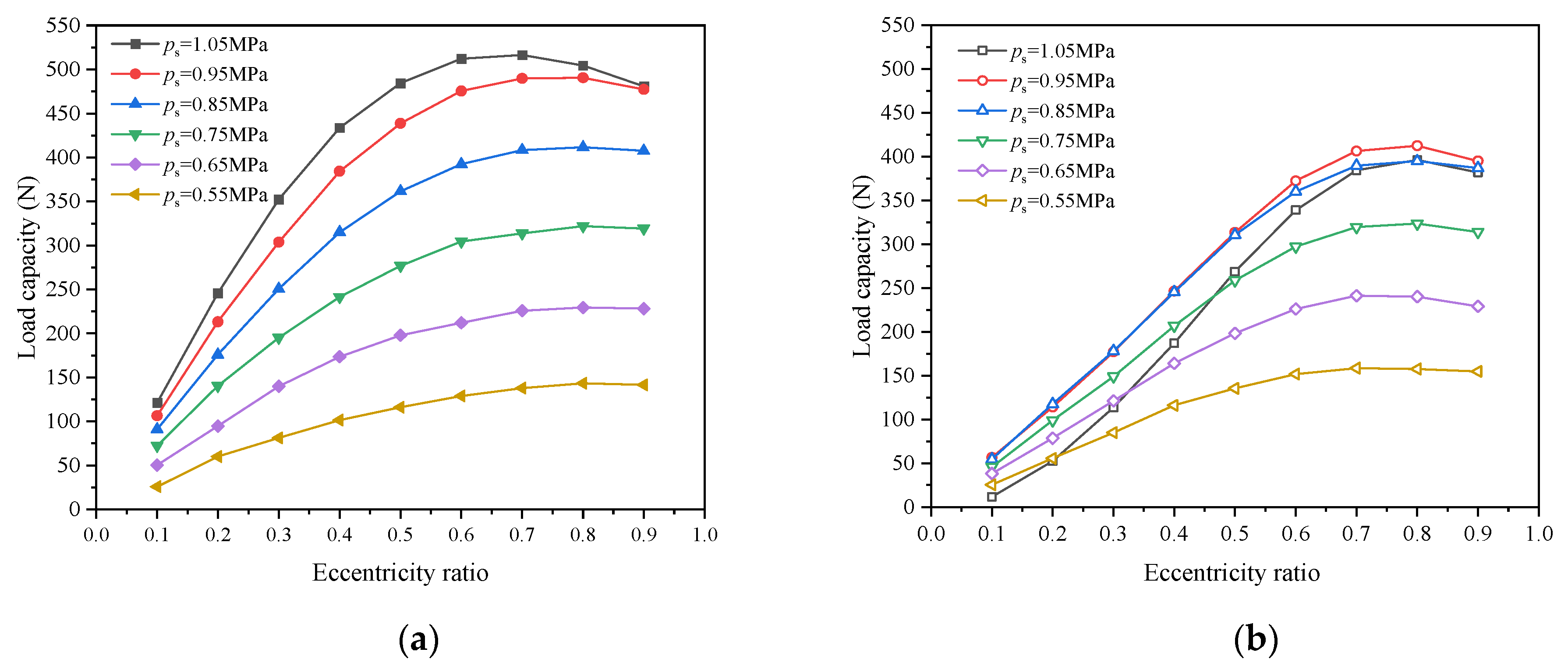
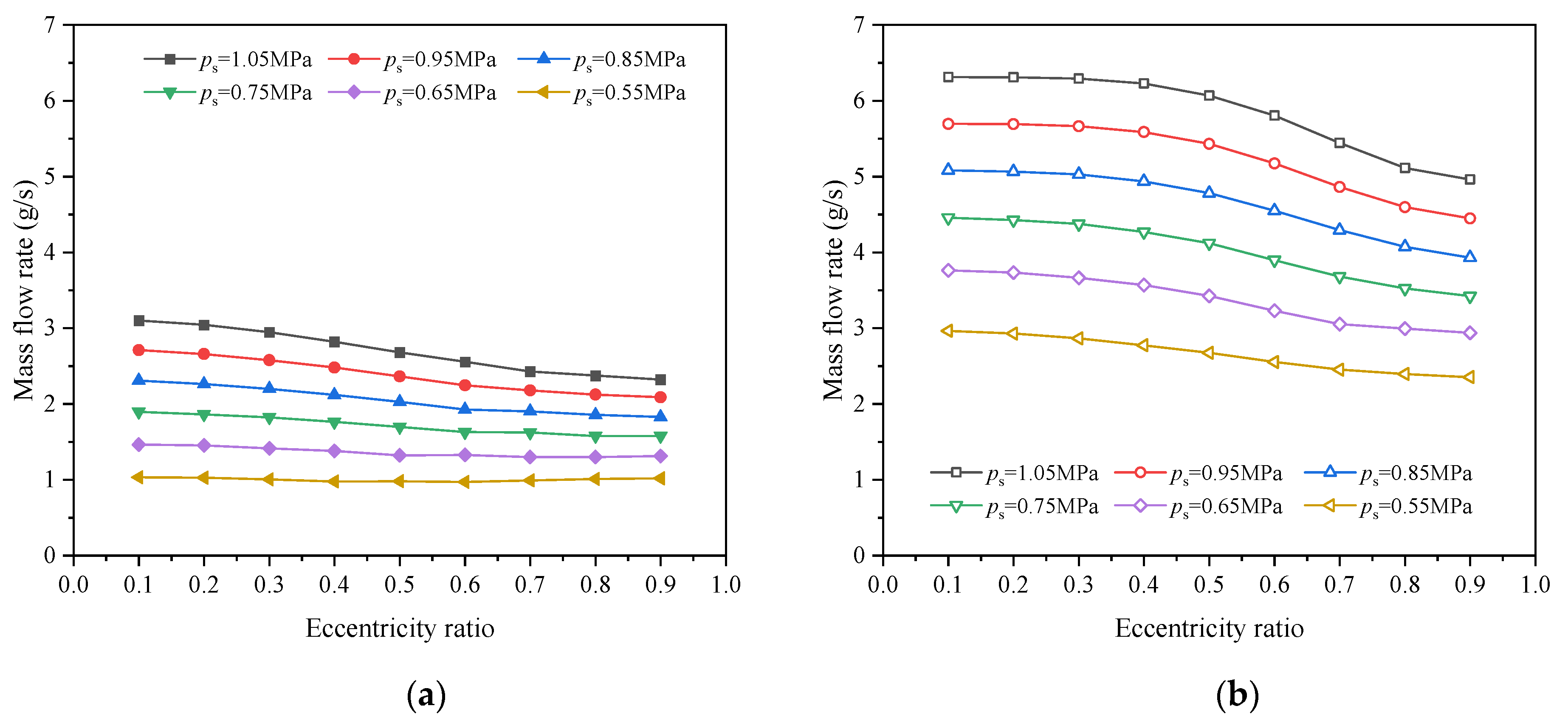
Publisher’s Note: MDPI stays neutral with regard to jurisdictional claims in published maps and institutional affiliations. |
© 2022 by the authors. Licensee MDPI, Basel, Switzerland. This article is an open access article distributed under the terms and conditions of the Creative Commons Attribution (CC BY) license (https://creativecommons.org/licenses/by/4.0/).
Share and Cite
Ma, C.; Yang, Q.; Sun, X.; Zhang, K.; Li, L. Performance Analysis of Externally Pressurized Gas Journal Bearing Lubricated with Vapor of R134a in Centrifugal Compressor. Processes 2022, 10, 2067. https://doi.org/10.3390/pr10102067
Ma C, Yang Q, Sun X, Zhang K, Li L. Performance Analysis of Externally Pressurized Gas Journal Bearing Lubricated with Vapor of R134a in Centrifugal Compressor. Processes. 2022; 10(10):2067. https://doi.org/10.3390/pr10102067
Chicago/Turabian StyleMa, Can, Qichao Yang, Xiaohang Sun, Kelong Zhang, and Liansheng Li. 2022. "Performance Analysis of Externally Pressurized Gas Journal Bearing Lubricated with Vapor of R134a in Centrifugal Compressor" Processes 10, no. 10: 2067. https://doi.org/10.3390/pr10102067




